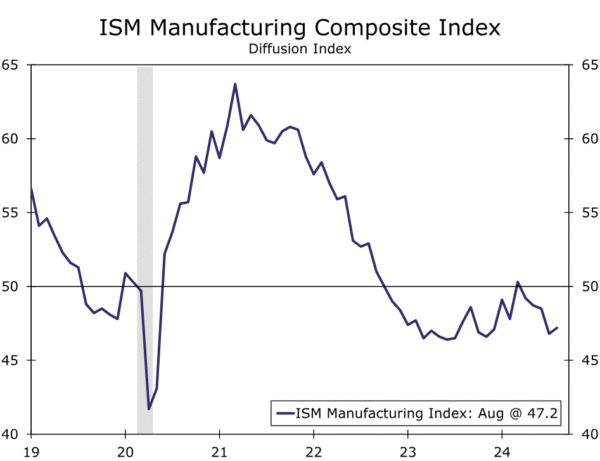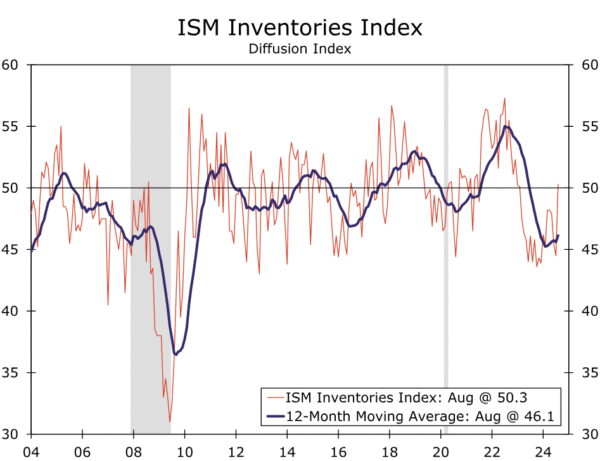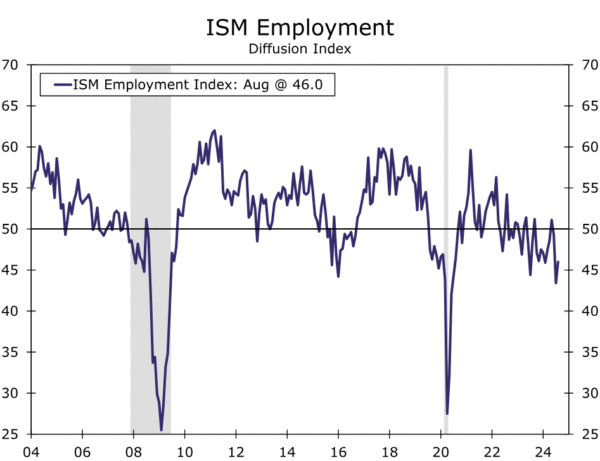Summary
A headline increase to 47.2 for the ISM manufacturing index says more about a back-up in inventories than it does about a meaningful improvement for the factory sector. Excluding the inventory contribution, the index would have been down 0.8 points.
Rise & Whine: More of the Same from August ISM
This is not the sort of improvement you want to see if you are rooting for a turnaround in the factory sector. Only two of the five components that feed into the headline rose in August. Employment (up 2.6 to 46.0) and inventories, which rose twice as much (+5.8 points to 50.3). Production, supplier deliveries and new orders were all lower. The most disconcerting development is the 2.8 point drop in new orders, which took this leading indicator to its lowest since May of last year.
While a sub-50 print may indicate a discouraging backdrop for the factory sector, it takes an even lower reading to signal outright recession for the broader economy; 42.5 in fact, according to the ISM. So today’s report for August activity is broadly consistent with a theme that has been in place for the better part of the past two years: the economy is still expanding even if the factory sector is not.
Our way of describing this dichotomy has been that the combination of pulled-forward demand for durable goods during the pandemic and higher financing costs has meant that Fed rate hikes have bitten harder in this sector than most others. Both of these dynamics are transitioning in a way that we expect to eventually be favorable for the sector. Even long-lived durable goods need replacing and items purchased during the early days of the pandemic are now four-and-a-half years old and rates are apt to start coming down, perhaps as soon as later this month. But for August, it was more of the same for manufacturing.
In general manufacturing activity remains constrained. The new orders component slid nearly three points to the lowest reading since May of last year, and the only of the six largest industries to report an increase in new orders was the computer & electronic products—which has been a notable bright spot in an otherwise flagging sector. The measure of current production also slid deeper into contraction last month.
As mentioned, most of the strength came from inventories. While inventories can be volatile, it’s the first time this component crested above 50 since early 2024 and the release notes manufacturers adjusting to lower output levels and timing issues. In other words, this inventory was unintended and a consequence of slowing demand. Without the inventory build, the overall ISM composite index would have seen a decline twice as large in August.
Slower activity continues to hold back hiring. We often look to the ISM surveys for a hint of what to expect from the coming employment report, and although the ISM’s have been more volatile than broader hiring figures, the signal has been clearly one of lost momentum. While employment was less negative in August, it was still consistent with a broad contraction in hiring in August. Only three of 18 industries reported employment growth in August according to the release, and one of them (food & beverage) was said to do so due to seasonal reasons. The employment component has only been above 50, or consistent with an expansion in hiring, for just one month of the year.
The main event this week comes with Friday’s employment report. We forecast a partial rebound in hiring and reversal of the unemployment rate from July’s increase. With the labor market now largely having normalized from its pandemic-related distortions the only question that remains is by how much will the Fed cut rates in two weeks at its September meeting. Recent public comments of Fed officials indicate few currently see the need for a 50 bps reduction, and we expect Friday’s jobs report will likely need to come in weaker than July for such a large rate reduction to kick off the Fed easing cycle.














